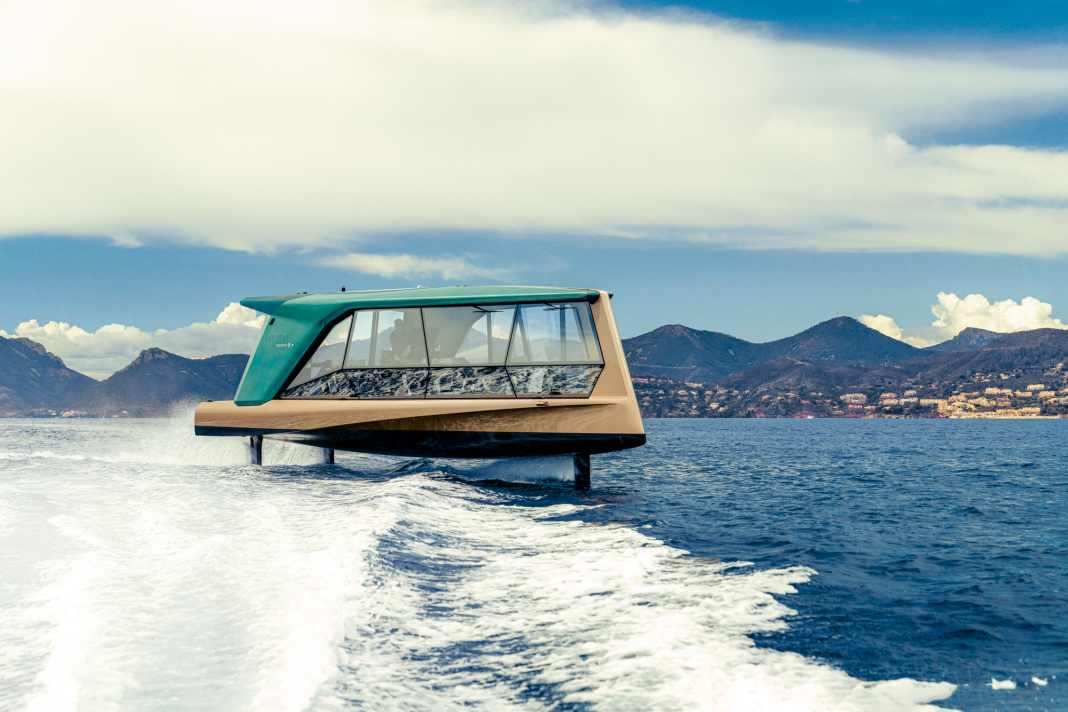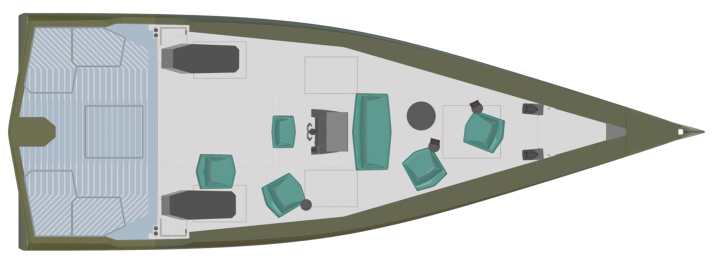





There has never been a yacht premiere amidst the glamour and hustle and bustle of the Cannes Film Festival before. While hundreds of police try to keep tens of thousands of tourists on a celebrity sightseeing tour at bay on the Croisette, which is closed to traffic, paparazzi climb their ladders in front of the Palais de Festival and women in extravagant haute couture dresses stroll down the red carpet, a 13-metre yacht hangs on a Tesla-like charging station at the neighbouring Jetée Albert Edouard in the Vieux Port of Cannes, waiting for its next deployment, this time with BOOTE EXCLUSIV on board.
"Welcome aboard 'The Icon'," Tyde's Managing Director Christoph Ballin warmly greets me on the aft deck of the novelty, whose existence was only known to a very small circle of people until a few weeks ago. Nothing had been made public in the run-up to the world premiere, no renderings, drawings or technical data that would have provided information about what to expect in the old harbour of Cannes. Only this much had been revealed by the press officers: "Go there, it's worth it! That's all we can say."
A milestone in yacht history
But ignorance has a marvellous advantage: you are unbiased and can let everything sink in on the spot, true to the motto: first impressions count. And the first impression did not disappoint: "Glass houseboat", "Much smaller than I expected" and "Wow, how big are the glass fronts and how low is the freeboard?" were the spontaneous reactions of my brain when I saw "The Icon". And the longer I looked at the floating object, the more amazed I was. I had never seen anything like it before - such an extravagant format could easily be described as a milestone in yachting history, if only because of the wealth of innovations implemented.
However, the 13.15 metre long boat, which displaces ten tonnes, is not exactly a yacht in the traditional sense. "This is just the beginning," reveals Ballin, who has set up his tech start-up Tyde in Starnberg. "Construction number 01 is our demonstration model, with which we want to show the world what 'The Icon' is and can be. Yacht, shuttle, ferry - we can fulfil every wish." First and foremost, the new vehicle is an exclamation mark that runs exclusively on electricity and glides efficiently over the surface of the water thanks to its foils!
The battery capacity of "The Icon" currently allows a range of 50 nautical miles at a stretch. Whisper-quiet nautical miles, mind you, as there are no waves slapping against the hull at speed and the two 100-kilowatt Deep Blue motors from Torqeedo hum quietly and evenly even at a top speed of 30 knots. The exterior, dominated by large glass panels arranged in a prism shape, and the modern interior of the glider were created in close collaboration with the globally active creative forge Designworks, a subsidiary of BMW. Best described as a "luxury tourer", construction number 01 differs significantly from any normal yacht, as the format was built as a demonstration model. The saloon, flooded with natural light, is the only room on board; there is no toilet, bathroom, galley or guest suite.
"The Icon" - a space without borders
The designers aptly call the concept "Infinite Space", a space without boundaries. They designed "The Icon" from the inside out, creating a protected microcosm with maximum panoramic views. "The idea from the outset was that we could also be as close to nature as possible inside," summarises Christoph Ballin. The interior features a blue carpet and a few pieces of furniture made from Exyd chrome steel sheets, the surface of which reflects the sunlight. These include two large sideboards in front of the aft sliding glass door and four 360-degree swivelling armchairs plus a two-seater bench in front of the centrally located helm station, which is based on the instrument design of electric BMW models with its 32-inch touchscreen with 6K resolution. All relevant nautical charts, boat, weather and routing details can be called up via the display. The Orca navigation system has been integrated for this purpose. Key functions can also be called up by voice command. The boat is steered using a steering wheel or intuitive joystick control, which makes manoeuvring easier, especially in narrow marinas.
Climate-friendly mobility also in the maritime high-end segment
During development, the team freed itself from the usual conventions right from the start. "Our aim was not just to design a boat, but to create our own experience on the water," Ballin proudly reveals. BMW's long-standing involvement in the America's Cup, the premier class of sailing, was also groundbreaking during the design phase. A large team of engineers succeeded in bridging the gap between maritime technology and advanced electromobility. Experts from all over the world were brought on board - including Guillaume Verdier, one of the leading designers of fast and extremely efficient sailing yachts and, among other things, jointly responsible for the design of the hull and foils of the last America's Cup winning boat, Emirates Team New Zealand. The still young company Tyde also contributed expertise on a large scale, as Tyde CEO Christoph Ballin, who was Managing Director of the Bavarian company Torqeedo for many years, played a key role in making electric drives suitable for everyday use on the water. "With "The Icon", we can also anchor climate-friendly mobility in the maritime high-end segment," says Ballin confidently.
How "The Icon" is powered
As travelling on water is around ten times more energy-intensive than on land due to the hull resistance, it was clear from the outset that "The Icon" had to be foiled. "This is the only way to save a substantial amount of energy and the only way we were able to realise a purely electric drive based on six marinised BMWi3 batteries with a total energy content of 240 kilowatt hours," says the Tyde boss. The foils are a system consisting of a front and a long rear wing, which are connected to the flat GRP hull with profiled masts. Trim tabs on both foils and rudders on the aft masts control the flight and steer the course as specified by the captain.
One of the most complex technical issues during the foiling phase is the control of the trim and control flaps via an on-board computer in real time, based on the movements of the boat, the height and direction of the waves and the speed. This is the only way to keep the boat in a stable flight position and prevent it from suddenly falling abruptly to the water's surface in sharp bends at 25 knots, which would lead to a dramatic and dangerous emergency stop. The Munich-based company Ocean Flight Technologies was responsible for this highly complex development process and was the first to venture out of the air and into the water. The implemented sensor technology works in the kilohertz range, the motion sensors analyse data thousands of times per second in order to adjust the control of the foils accordingly. An amazing computing power that works impressively, because the Tyde-Foiler is intuitive and very easy to control and operate, as I learnt during an extensive test ride in the Bay of Cannes.
Two towing propellers on the rear foil are controlled via the synchronised command transmitter, which quickly accelerate the GRP/carbon glider built by J&J in Slovenia. It takes around 15 seconds for "The Icon" to take off at 16 knots SOG and switch to flight mode, which is accompanied by an impressive sound composed by Oscar-winner Hans Zimmer that sounds something like an aeroplane taking off melodically. A Dolby Atmos system consisting of 13 loudspeakers plus subwoofer provides the perfect three-dimensional sound. And suddenly everything is silent as you glide along about a metre above the surface of the water and continue to accelerate up to 30 knots - without any splashing water on the stern and the usual boat movements when pitching into or over waves. "The Icon" gives the passengers and me as the helmsman a feeling of absolute safety. Even in bends, which, mind you, should not be taken too hectically and abruptly, the luxury tourer behaves good-naturedly and follows the steering commands as if on rails. And that at 25 knots! The full glass of water that Christoph Ballin places on the side table between the front seats for demonstration purposes during the flight doesn't budge an inch and the water in it only moves minimally. And how does the landing work? Quite simply, the speed is reduced via the command transmitter until the underside of the hull touches the water surface again at 18 knots, also accompanied by an immersive touchdown soundscape by Hans Zimmer, which can of course also be switched off.
How is safety guaranteed on board "The Icon"?
Anyone seeing the Tyde innovation for the first time will inevitably ask themselves how safety can be guaranteed with a freeboard of less than one metre and a structure that consists of 80 percent glass. "As you can imagine, the topic of glass was a story in itself, as the lower glass panels close to the water in particular have to be particularly impact-resistant in order to withstand the impact of larger waves under certain circumstances," explains Christoph Ballin. "The glass was developed in collaboration with AGC Glass Europe, and the company Sedak in Gersthofen was responsible for production. It is a glazing in accordance with ISO standard 12216, consisting of three laminated layers of chemically hardened and coated glass, which are firmly bonded to a carbon frame structure." The foiling glass house was also an unusual project for the DNV classification society, which issued it with a hull construction certificate and a compliance statement similar to category C for wind forces of up to six Beaufort and significant wave heights of up to two metres. However, "The Icon" will not normally set sail in these conditions. "We can easily foil at high speed in wave heights of up to 1.50 metres, but we don't recommend it in higher swell," says Christoph Ballin.
Car brands venture onto the water
It is by no means unusual for car brands to venture into the maritime sector. Over the last decade, Mercedes (Arrow 460), Porsche Design (GTT 115), Bugatti (Niniette 69), Aston Martin (AM37), Lamborghini (Tecnomar for Lamborghini 63) and Lexus (LY650) have presented floating formats that have caused a sensation. With "The Icon", which costs between 2.2 and 2.5 million euros depending on the equipment, Tyde and BMW have succeeded in launching a UFO that can contribute to adding a new chapter to the history of maritime mobility thanks to its ground-breaking design and innovative diversity. Ballin and his team are only at the beginning. Two further, significantly larger foiling models are in the works, with all the amenities that belong to a superyacht.
Technical data

- Length over everything:13,15 m
- LWL: 12,95 m
- Width:4,50 m
- Depth: 1,87 m
- Draught (foiling): 0,85 m
- Displacement (empty): 10 t
- Material: GRP/carbon
- Motors:2 x Torqeedo Deep Blue 100
- Engine power: 2 x 100 kW
- Batteries:6 x BMWi3
- Battery capacity:240 kWh
- Speed (max.): 30 kn
- Speed (travelling): 24 kn
- Navigation:Orca
- Glass: AGC Glass Europe, Sedak
- Construction: Guillaume Verdier
- Exterior design:BMW Designworks
- Interior design: BMW Designworks
- Shipyard:Tyde, J&J
- Class:DNV
- Starting price: 2.2 to 2.5 million euros

